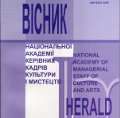СИНКРЕТИЗМ ЦЕРКОВНОЇ ПОХОВАЛЬНО-ОБРЯДОВОЇ МУЗИКИ ТА ФОЛЬКЛОРНИХ ЕЛЕМЕНТІВ У ПРАВОСЛАВНІЙ ТРАДИЦІЇ
Syncretism of Church Burial and Ritual Music and Folklore Elements in Orthodox Tradition
Author(s): Olga SapozhnikSubject(s): Customs / Folklore, Music, Culture and social structure , Sociology of Art, Sociology of Religion, History of Art
Published by: Національна академія керівних кадрів культури і мистецтв
Keywords: Ukrainian Orthodox tradition; burial and ritual music; church chants; ritual folklore;
Summary/Abstract: The purpose of the article is to discuss the mutual influence of funeral and ritual music and folklore ritual traditions of Ukrainian Orthodoxy. The specifics of the development of folk beliefs, customs and church ritual, and burial music are investigated. It is indicated that Orthodox sacred music developed in interaction with centuries-old folk melos and became the basis for the development of church musical culture. The study aims to identify the relationship of burial ritual music and folklore elements in church chants of the Orthodox tradition, to outline the phenomenon of church burial and ritual music as a specific way of spiritual communication, catharsis, emotional and figurative assimilation, and reflection of personal worldview. The research methodology comprises the general scientific methods of analysis: historicism, systematisation, comparison, and generalisation of the problem under study. Scientific novelty of the research lies in clarifying the fixation and elaboration of the Orthodox taphological repertoire; in the study of the mutual influence of folk household and burial beliefs, customs and church ritual, and burial music of Orthodox Christians on the cultural identity of Ukrainians, their worldview, and national genotype. Conclusions. In the musical burial ritualism of Ukrainians, the symbiosis of customs, beliefs, and church rites is still clearly traced. All of them are aimed to convert an Orthodox Christian to a righteous, sinless life, to the hope of forgiveness and remission of sins, and to giving peace to the soul after death in anticipation of the Kingdom of Heaven, eternal life. They also intend to cleanse the living space from negative action, to ensure the successful transition of the soul of the deceased to the Kingdom of God, to protect living relatives and to unite the living and the dead from the family in Holy Communion (Eucharist). The Orthodox musical and aesthetic tradition states that the soul’s prayer of the deceased is strong and effective in God. Consequently, Christians have a firm belief that the souls of the dead pray for their living descendants of each kin, and the mission of the living is to pray for the eternal peace of their souls and the universal resurrection in the Kingdom of Heaven. If we are to achieve a fullness of synergistic communion with the Lord, we must not only rely on God's help, but also make our spiritual contribution through spiritual effort and compassionate strain, kenosis, self-sacrifice, and personal predestination to the Good. The phenomenon of church burial and ritual music appears as a specific way of spiritual communion, emotional and figurative mastering and reflection of the worldview of an Orthodox Christian, which gives rise to an ethno-national type of a person’s musical and aesthetic thinking, and cultural self-identification. With the help of church chants, including pure funeral and ritual songs, Ukrainian musical culture became the personification of religious and aesthetic ideals, and mental-ideological attitudes of Orthodoxy. This influenced the processes of national identification and left a characteristic imprint on the ethno-national mentality and spiritual and musical culture of Rus-Ukraine throughout the centuries.
Journal: Вісник Національної академії керівних кадрів культури і мистецтв
- Issue Year: 2023
- Issue No: 1
- Page Range: 269-275
- Page Count: 7
- Language: Ukrainian

